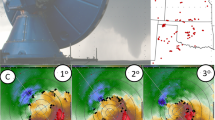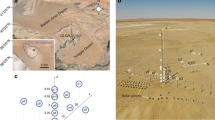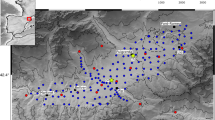Abstract
KNOWLEDGE of the kinematic structure of storms is important for understanding the internal physical processes. Radar has long provided information on the three-dimensional structure of storms from measurements of the radar reflectivity factor alone. Early users of radar gave total storm movement only, whereas later radar data were used to reveal internal motions based on information related to cloud physics such as the three-dimensional morphology of the storm volume. Such approaches have continued by using the increasingly finer scale details provided by more modern radar systems. Both Barge and Bergwall2 and Browning and Foote3 have used fine scale reflectivity structure to determine airflow in hailstorms. Doppler radar added a new dimension to our capabilities through its ability to measure directly the radial component of motion of an ensemble of hydrometeor particles. Two4 or three5 Doppler radars collecting data in conjunction, the equation of mass continuity, and an empirical radar reflectivity–terminal velocity relationship have enabled the estimation of the full three-dimensional airflow fields in parts of storms. Because of the inherent advantage of Doppler radar in motion detection, little effort has been directed toward developing objective schemes of determining internal storm motions with conventional meteorological radars. Pattern recognition schemes using correlation coefficient techniques6, Fourier analysis7, and gaussian curve fitting8 have been used with radar and satellite data, but primarily for detecting overall storm motions, echo merging and echo splitting. Here we describe an objective use of radar reflectivity factor data from a single conventional weather radar to give information related to the three-dimensional motions within a storm.
This is a preview of subscription content, access via your institution
Access options
Subscribe to this journal
Receive 51 print issues and online access
$199.00 per year
only $3.90 per issue
Buy this article
- Purchase on Springer Link
- Instant access to full article PDF
Prices may be subject to local taxes which are calculated during checkout
Similar content being viewed by others
References
Browning, K. A. J. atmos. Sci. 22, 669–677 (1965).
Barge, B. L. & Bergwall, F. Atmos. Sci. Rep. 76–2 (Alberta Research Council, 1976).
Browning, K. A. & Foote, G. B. Q. J. R. meteor. Soc. 102, 499–533 (1976).
Lhermitte, R. M. & Gilet, M. J. appl. Meteor. 14, 1346–1361 (1975).
Lhermitte, R. M., Gilet, M., Sashegyi, K. & Cunning, J. 10th Conf. Severe Local Storms, Omaha (Am. meteor. Soc., Boston, 1977).
Hilst, G. R. & Russo, J. A., Jr, Tech. Memo. No. 3, Travelers Weath. Res. Cntr. (1960).
Östlund, S. S. NOAA Tech. Memo ERL WMPO-15 (US Dept of Comm. NOAA Environmental Res. Lab., 1974).
Wiggert, V., Östlund, S., Lockett, G. & Stewart, J. NOAA Tech. Memo ERL WMPO-35 (US Dept of Comm. NOAA Environmental Res. Lab., 1976).
Peslen, C. A. 10th Conf. Severe Local Storms, Omaha (Am. meteor. Soc., Boston, 1977).
Harris, F. I., Fankhauser, J. C. & Miller, J. R. 18th Conf. Radar Meteor., Atlanta (Am. meteor. Soc., Boston, 1978).
Author information
Authors and Affiliations
Rights and permissions
About this article
Cite this article
RINEHART, R., GARVEY, E. Three-dimensional storm motion detection by conventional weather radar. Nature 273, 287–289 (1978). https://doi.org/10.1038/273287a0
Received:
Accepted:
Issue Date:
DOI: https://doi.org/10.1038/273287a0
This article is cited by
-
Radar precipitation nowcasting based on ConvLSTM model in a small watershed in north China
Natural Hazards (2024)
-
Large-scale dynamics moderate impact-relevant changes to organised convective storms
Communications Earth & Environment (2023)
-
Evaluation of Alpine-Mediterranean precipitation events in convection-permitting regional climate models using a set of tracking algorithms
Climate Dynamics (2023)
-
A rain-type adaptive optical flow method and its application in tropical cyclone rainfall nowcasting
Frontiers of Earth Science (2022)
-
Thinking fast and slow in disaster decision-making with Smart City Digital Twins
Nature Computational Science (2021)
Comments
By submitting a comment you agree to abide by our Terms and Community Guidelines. If you find something abusive or that does not comply with our terms or guidelines please flag it as inappropriate.



